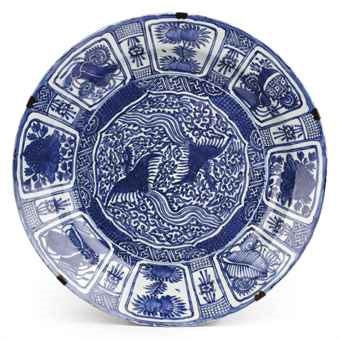Of round form, painted in underglaze blue enamels, the central star-shaped cavetto decorated with two phoenixes in flight chasing each other set on a ground of cloud scrolls, the wide rim with eight large panels decorated with auspicious objects like a double gourd and a large fan alternated with stylised sunflowers and flowers, each shaped panel separated by narrow bands decorated with tassels, the back with a further eight stylised panels divided by narrow bands.
Literature
For an example of another Kraak charger decorated with phoenix but smaller see Maura Rinaldi, Kraak Porcelain - A Moment in the History of Trade, Bamboo Publishing Ltd, London 1989, pl. 94, p. 104 and for a discussion in the same book on the extreme rarity of this decoration see page 102 from which we quote: "Dishes with the dragon, the symbol of the Emperor are rare, but dishes with phoenixes (the symbol of the Empress) are even rarer. One is in a private collection in England (originally from the Netherlands) (pl. 94). Another, lodged in the ceiling of a room in the Santos Palace in Lisbon, may well be unique for the quality of the painting (Lion-Goldschmidt 1984, pls. 102, 103). This large dish, with unglazed base, has a decoration on the border as well as on the underside which is typical of this group. Another dish with phoenixes in the large medallion was found among the Witte Leeuw shards (Pijl-Ketel 1982, p. 63, no. 2019.)"
An earlier example dated to the Xuande period, Ming Dynasty, with a decoration of phoenix flying through flowers is in the Beijing Palace Museum, illustrated in Blue and White Porcelain with Underglazed Red (I),The Complete Collection of Treasures of the Palace Museum, pl. 133.

